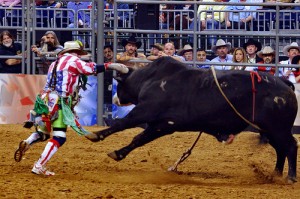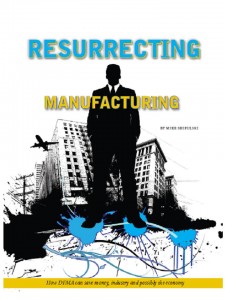Archive for June, 2010
Anyone want to save $50 billion?
 I read a refreshing article in the Washington Post. Defense Secretary Robert M. Gates wants to save $20B per year on the Pentagon’s spend. I could kiss this guy!
I read a refreshing article in the Washington Post. Defense Secretary Robert M. Gates wants to save $20B per year on the Pentagon’s spend. I could kiss this guy!
Gates wants contracts scrutinized more closely for inefficiencies and unneeded overhead. He said the savings could be shifted to support U.S. troops around the globe. Pentagon officials said they’re looking for annual savings in the $400 billion spent on goods and services. They’re looking to save $20B, or 5%.
Gates has it right. The government must stop overpaying. But how? Gates suggests improved contract scrutiny to eliminate inefficiencies and unneeded overhead. He’s on the right track, but that’s not where the money is. Gates’ real target should be material cost – that’s where the money is. But, can material cost bring $20B savings? Yes.
Assume the Pentagon spends $100B on services and $300B on goods. The cost of those of goods falls into three buckets: labor, material, and overhead, where material cost makes up the lion’s share at 70%, or $210B. A 10% reduction in material cost brings $21B in savings, and gets Gates to his target. But how?
To get the savings, the Pentagon must drive the right behavior. They must must make suppliers submit a “should cost” with all proposals. The should cost is an estimated cost based on part geometries, materials, manufacturing processes used to create the parts, prevailing wage rates and machine rates, and profit. From these parameters, a should cost can be created in the design phase, without actually making the parts. So, the Pentagon will know what they should pay before the product is made. This cost analysis is based on real data, real machines, and real material costs. There is no escape for defense contractors. The cash cow is no longer.
Should costing will drive the design engineers to create designs that work better and cost less, something the defense industry thinks is impossible. They’re wrong. Given the tools, time, and training, the defense industry’s design engineering community can design out at least 25% of material cost, resulting in $50B+ in savings, more than twice Gates’ goal. Someone just has to teach them how.
Mr. Secretary, the non-defense world is ready to help. Just ask us. (But we’ll go after a 50% cost reduction.)
Back to Basics with DFMA
 About eight years ago, Hypertherm embarked on a mission to revamp the way it designed products. Despite the fact its plasma metal-cutting technology was highly regarded and the market leader in the field, the internal consensus was that product complexity could be reduced and thus made more consistently reliable, and there was an across-the-board campaign to reduce product development and manufacturing costs. Instead of entailing novel engineering tactics or state-of-the-art process change, it was a back-to-basics strategy around design for manufacture and assembly (DFMA) that propelled Hypertherm to meet its goals.
About eight years ago, Hypertherm embarked on a mission to revamp the way it designed products. Despite the fact its plasma metal-cutting technology was highly regarded and the market leader in the field, the internal consensus was that product complexity could be reduced and thus made more consistently reliable, and there was an across-the-board campaign to reduce product development and manufacturing costs. Instead of entailing novel engineering tactics or state-of-the-art process change, it was a back-to-basics strategy around design for manufacture and assembly (DFMA) that propelled Hypertherm to meet its goals.
The first step in the redesign program was determining what needed to change. A steering committee with representation from engineering, manufacturing, marketing, and business leadership spent weeks trying to determine what was required from a product standpoint to deliver radical improvements in both product performance and product economics. As a result of that collaboration, the team established aggressive new targets around robustness and reliability in addition to the goal of cutting the parts count and labor costs nearly in half.
Be Authentic
 You’re sitting in a big meeting discussing an issue, and consensus is nowhere to be found. There are two camps and you’re in neither. And the big kahuna has marked her territory – you know where she stands. Frustrated by the lack of consensus she looks you in the eye and asks, “What do you think?” What do you do? Do you tell her what you really think or do you tell her what she wants to hear? More and more, it’s the latter. We’ve become too conflict averse. We’re so conditioned to avoid conflict we don’t even consider saying what we think. We go right to what they want to hear. Sad.
You’re sitting in a big meeting discussing an issue, and consensus is nowhere to be found. There are two camps and you’re in neither. And the big kahuna has marked her territory – you know where she stands. Frustrated by the lack of consensus she looks you in the eye and asks, “What do you think?” What do you do? Do you tell her what you really think or do you tell her what she wants to hear? More and more, it’s the latter. We’ve become too conflict averse. We’re so conditioned to avoid conflict we don’t even consider saying what we think. We go right to what they want to hear. Sad.
I argue it’s best to be authentic at all costs – tell them what you think and why. This approach does not minimize stress in the short term, like the next several days after the meeting. But it’s the least stressful over the long haul. First, once the kahuna calms herself and thinks about what you said, she’ll be happy you gave her the truth. You educated her. Even if she does not end up agreeing with your thinking, you gave her a broader perspective, a more complete view of the situation. She’s smart. She’ll see what you did for her. She’ll come around. Second, and more importantly, you’ve been true to yourself – no internal stress whatsoever. You’ve been authentic. You’ve been you.
You’re most effective when you’re you. You’re comfortable, you’re genuine, and you’re believable. And you’re stressed as hell when you pretend. Not believable. Faking doesn’t feel good, and it’s hard. It’s like wearing shoes that are two sizes too small – they’re not yours, and they hurt. You’re hobbled by them. People see the wincing as you shuffle through your day. They see the tension in your body. They know something is not right and they judge your words accordingly. Bad.
It takes big balls to be authentic. There are negative consequences. Some get pissed when you tell it like it is. So be it. And clear, focused thinking can be threatening. So be it. But the positives outweigh the negatives. Your organization is better for your thinking, and, most importantly you get to be you. Priceless.
Level 5 Courage
 Level 5 Courage is hard to describe and harder to recognize. What is it? Who has it? What is it good for? To understand it, look to the rodeo clown.
Level 5 Courage is hard to describe and harder to recognize. What is it? Who has it? What is it good for? To understand it, look to the rodeo clown.
You’ve seen the rodeo clown. A strange looking thing – funny clothes that don’t fit, a silly hat that doesn’t stay on, and bright red suspenders meant for bulls not pants. He’s all fun and games on the surface, but serious as a heart attack when seen at depth. Underneath the clownness he does serious, meaningful work, work for the benefit of others.
Surely the cowboy needs gumption to sit atop a big, angry bull, a bull whose sole purpose is to use his raging bullness to enthusiastically eject his unwelcomed rider. Certainly the cowboy has courage. But is it Level 5 Courage? Maybe.
What’s the first thing the cowboy does after being pitched to the dirt? He gets up and runs like hell away from the bull. And the clown? He runs like hell toward the bull. When everything natural says run away, the unnatural rodeo clown runs toward. And he runs with purpose, with precision, with intent. He runs at the pointy parts, and he runs to re-aim them. Level 5 Courage – guaranteed.
a
This cannot be taught – rodeo clowns are born, not made.
a
When the crowd sits in the grandstand they want to see the cowboy. But when the cowboy sits on the bull he wants to see the clown. Sitting atop an angry, frothing bull, knowing the fury to follow, the cowboy finds comfort in the funny clothes hiding behind the barrel. With the briefest eye-to-eye connection the pact is made. The cowboy knows it will be all right. No mater what, the clown will be there – guaranteed. Even at the expense personal safety. The clown gets meaning from this work. This is why he is a clown.
There is a powerful bond between clown and cowboy. And cowboys always buy the beer. Always. Cowboys understand clowns are special and clowns like to be appreciated for what they really are. It works for both.
Cowboys are right – rodeo clowns are special, but they’re hard to recognize; you must look deeply to see them. So keep an eye out. Once you recognize them, don’t make them turn in their funny clothes and suspenders. Appreciate them for what they are and they will make things all right. Level 5 Courage – guaranteed.
What we can learn from Balsamic Vinaigrette
 Balsamic Vinaigrette – done well it’s made from good balsamic vinegar and extra-virgin olive oil (EVOO) with a couple minor players thrown in as needed. Balsamic – dark, rich, full of spirit, bold, big personality. EVOO – deep yellow-green, thick, unflappable, broad-shouldered. Separately, they have their strengths and they know what they’re good at. But together they’re magic – strengths amplified, weaknesses canceled – which is strange, because they really don’t like each other. When co-located, it’s grapes with grapes and olives with olives, circling the wagons for self preservation, like two teams in the same locker room, two sects in the same country, or two silos in the same company. For old grape juice and olive blood, co-location is not enough. An external force is needed – their bottle must be shaken a little.
Balsamic Vinaigrette – done well it’s made from good balsamic vinegar and extra-virgin olive oil (EVOO) with a couple minor players thrown in as needed. Balsamic – dark, rich, full of spirit, bold, big personality. EVOO – deep yellow-green, thick, unflappable, broad-shouldered. Separately, they have their strengths and they know what they’re good at. But together they’re magic – strengths amplified, weaknesses canceled – which is strange, because they really don’t like each other. When co-located, it’s grapes with grapes and olives with olives, circling the wagons for self preservation, like two teams in the same locker room, two sects in the same country, or two silos in the same company. For old grape juice and olive blood, co-location is not enough. An external force is needed – their bottle must be shaken a little.
When it’s game time, when it’s time to perform, when the shit hits the fan (or lettuce), grapes must make nice with olives and vice versa. But who makes the first move? How can an old grape reach out to a squished olive and still stay true to the Balsamic cause? How can they be mixed, shaken, and poured for the common cause? It’s all about the mixer/shaker/pourer.
Here is a little inside information about grapes and olives: Grapes don’t take direction from the chief of clan EVOO and olives don’t listen to the boss Balsamic. What’s needed is a mixer/shaker/pourer that is BOTH a trusted old grape who has lived through a good foot stomping AND a trusted old olive who has experienced the pain of a first pressing. Trust is essential. Look what we’re asking them to do: parachute from their bottle, hit the battle front together, and fight as one. That’s scary. Trust is needed.
The best mixer/shaker/pourers are an enigma – part olive, part grape, yet neither; sometimes misunderstood but always trusted; supportive of team members while pushing them out of their comfort zone. They earn their salt – they get it done. They bring people together and make it happen. They amplify strengths and shore up weaknesses to achieve the multiplicative effect where team output is greater than the sum of the parts.
These folks have an important and difficult job. And it can be a bit lonely, as they are never wholly part of any one community. So when you see them in the hall, give them a smile. They like to be understood.
When Work Has Meaning
 Work can be good or bad, calming or frustrating, it can fly by or crawl. What’s makes the difference? Meaning. When work has meaning you are happy, and when it does not you are not happy. (Or you’re happy for a different reason, likely because of a meaningful relationship.) You wear happiness on your sleeve when work has meaning, so it’s clear to all which camp you’re in. Can’t hide it. But what does it mean for work to have meaning?
Work can be good or bad, calming or frustrating, it can fly by or crawl. What’s makes the difference? Meaning. When work has meaning you are happy, and when it does not you are not happy. (Or you’re happy for a different reason, likely because of a meaningful relationship.) You wear happiness on your sleeve when work has meaning, so it’s clear to all which camp you’re in. Can’t hide it. But what does it mean for work to have meaning?
Work has meaning when you see it as part of a bigger picture, when you see it as part of the bigger context, when you see it as knit into the big blanket of life, when you can see how other people benefit from your work, when you can see how society benefits from your work. It’s not just the big jobs that can have meaning – they all can, regardless of pay or status. Burger-flipper or CEO, teacher or janitor, writer or actor, all can find meaning in their work, or not.
Want to know if your work has meaning? Answer these questions for yourself:
- Who benefits from my work?
- How are they better off because of my work?
- How does my work enable others to help others?
- How does my work help children? (my favorite)
The questions help you place your work in the spider web that is society – an intricate network of thin connections. More connections radiating from your work, more meaning. The further outward your work can jiggle the web, the greater the meaning.
Let’s face it, we spend a lot time at work. You might as well enjoy it. So, search for meaning, think about how your work helps others, and place yourself in the biggest, baddest spider web you can spin, and jiggle the hell out of it.
a
Click this link for information on Mike’s upcoming workshop on Systematic DFMA Deployment
Cover Story IE Magazine – Resurrecting Manufacturing
 For too long we have praised financial enterprises for driving economic growth knowing full well that moving and repackaging financial vehicles does not create value and cannot provide sustainable growth. All the while, manufacturing as taken it on the chin with astronomical job losses, the thinnest capital investments and, most troubling, a general denigration of manufacturing as an institution and profession. However, we can get back to basics where sustainable economic growth is founded on the bedrock of value creation through manufacturing.
For too long we have praised financial enterprises for driving economic growth knowing full well that moving and repackaging financial vehicles does not create value and cannot provide sustainable growth. All the while, manufacturing as taken it on the chin with astronomical job losses, the thinnest capital investments and, most troubling, a general denigration of manufacturing as an institution and profession. However, we can get back to basics where sustainable economic growth is founded on the bedrock of value creation through manufacturing.
Continuing with the back-to-basics theme, manufacturing creates value when it combines raw materials and labor with thinking, which we call design, to create a product that sells for more than the cost to make it. The difference between cost (raw materials, labor) and price is profit. The market sets price and volume so manufacturing is left only with materials and labor to influence profit. At the most basic level, manufacturing must reduce materials and labor to increase profit. We can get no more basic than that. How do we use the simple fundamentals of reducing labor and material costs to resurrect U.S. manufacturing? We must change our designs to reduce costs using Design for Manufacturing and Assembly (DFMA).
The program is typically thought of as a well-defined toolbox used to design out product cost. However, this definition is too narrow. More broadly, DFMA is a methodology to change a design to reduce the cost of making parts while retaining product function. Systematic DFMA deployment is even broader; it is a business method that puts the business systems and infrastructures to deploy DFMA methods in place systematically across a company. In that way, it is similar to the better known business methodologies lean, Six Sigma and design for Six Sigma.
Click this link for the full story.
a
Click this link for information on Mike’s upcoming workshop on Systematic DFMA Deployment
 Mike Shipulski
Mike Shipulski